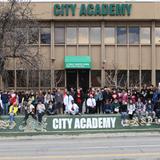Serving 99 students in grades 7-12, City Academy ranks in the bottom 50% of all schools in Utah for overall test scores (math proficiency is bottom 50%, and reading proficiency is bottom 50%).
The percentage of students achieving proficiency in math is 20-24% (which is lower than the Utah state average of 40%). The percentage of students achieving proficiency in reading/language arts is 20-29% (which is lower than the Utah state average of 43%).
The student-teacher ratio of 8:1 is lower than the Utah state level of 21:1.
Minority enrollment is 62% of the student body (majority Hispanic), which is higher than the Utah state average of 29% (majority Hispanic).
Quick Facts (2025-26)
- School Type: Charter School
- Grades: 7-12
- Enrollment: 99 students
- Student-Teacher Ratio: 8:1
- Minority Enrollment: 62%
- Graduation Rate: ≥80% (Btm 50% in UT)
- Overall Testing Rank: Bottom 50%
- Math Proficiency: 20-24% (Btm 50%)
- Reading Proficiency: 20-29% (Btm 50%)
- Science Proficiency: 20-29% (Btm 50%)
- Source: National Center for Education Statistics (NCES), UT Dept. of Education
Top Rankings
City Academy ranks among the top 20% of public schools in Utah for:
Category
Attribute
Diversity
Community Size
Student Attention
School Overview
City Academy's student population of 99 students has declined by 39% over five school years.
The teacher population of 13 teachers has declined by 23% over five school years.
School Type
Grades Offered
Grades 7-12
Total Students
99 students
Gender %
Total Classroom Teachers
13 teachers
Year Founded
2000
School Calendar
School Mascot
Wild Boars
School Rankings
City Academy ranks within the bottom 50% of all 957 schools in Utah (based off of combined math and reading proficiency testing data).
The diversity score of City Academy is 0.63, which is more than the diversity score at state average of 0.46. The school's diversity has stayed relatively flat over five school years.
Overall Testing Rank
#844 out of 957 schools
(Bottom 50%)
(Bottom 50%)
Math Test Scores (% Proficient)
20-24%
40%
Reading/Language Arts Test Scores (% Proficient)
(20-21)20-29%
43%
Science Test Scores (% Proficient)
(20-21)20-29%
45%
Student-Teacher Ratio
8:1
21:1
American Indian
1%
1%
Asian
5%
2%
Hispanic
48%
20%
Black
3%
1%
White
38%
71%
Hawaiian
n/a
1%
Two or more races
5%
4%
All Ethnic Groups
Graduation Rate
≥80%
88%
Eligible for Free Lunch
47%
24%
Eligible for Reduced Lunch
11%
6%
School Statewide Testing
School District Name
Source: National Center for Education Statistics (NCES), UT Dept. of Education
School Notes
- School Mascot: Wild Boars
Profile last updated: 02/09/2025
Frequently Asked Questions
What is City Academy's ranking?
City Academy is ranked #844 out of 957 schools, which ranks it among the bottom 50% of public schools in Utah.
What percent of students have achieved state testing proficiency in math and reading?
20-24% of students have achieved math proficiency (compared to the 40% UT state average), while 20-29% of students have achieved reading proficiency (compared to the 43% UT state average).
What is the graduation rate of City Academy?
The graduation rate of City Academy is 80%, which is lower than the Utah state average of 88%.
How many students attend City Academy?
99 students attend City Academy.
What is the racial composition of the student body?
48% of City Academy students are Hispanic, 38% of students are White, 5% of students are Asian, 5% of students are Two or more races, 3% of students are Black, and 1% of students are American Indian.
What is the student-teacher ratio of City Academy?
City Academy has a student ration of 8:1, which is lower than the Utah state average of 21:1.
What grades does City Academy offer ?
City Academy offers enrollment in grades 7-12
What school district is City Academy part of?
City Academy is part of City Academy School District.
In what neighborhood is City Academy located?
City Academy is located in the Central City neighborhood of Salt Lake City, UT. There are 3 other public schools located in Central City.
School Reviews
3 12/20/2025
City Academy has been a really positive experience for our family. The smaller size makes a big difference - teachers actually know the students and take the time to support them as individuals. Our child feels comfortable here and more engaged than at their previous school.The school has a welcoming, inclusive culture and offers flexibility that works well for students who don''t thrive in a traditional, large-school setting. Communication with teachers has been solid, and we''ve always felt heard when questions come up. It''s not a one-size-fits-all school, but for the right student, it can be a great fit.
1 10/10/2025
As a parent of a child who attended City for two years, I would caution any parent considering City. They have a revolving door of teachers, uncaring administration, and cannot individualize education in any way for your child. We have gone back to public school after City and are finding many more opportunities for our child and much more help.
5 10/10/2025
I am so thankful that I was able to attend City Academy in high school. Due to the small class sizes, I was able to receive individualized attention from each teacher, helping me to be successful throughout my schooling. Awesome teachers and small class sizes were the best fit for my education.
5 10/10/2025
It was a different school in 2011, now it has changed drastically. I went to West High before, where I was bullied and ridiculed, but at City the teachers care. The students rarely pick on one another now. It feels like home when I walk in the doors. They all want you to succeed, unlike other schools. The music program is amazing, as is the theatre program. Our STEM programs are outstanding. We may be little, but this school is fierce!
5 10/10/2025
This school saved my life! I came from a big school, and it ruined me. Made me a shell of a human. City Academy has undergone some serious changes, including firing and hiring new staff members, tweaking the rules, and becoming more involved. The school is amazing, and I recommend it to everyone!
2 10/10/2025
I attended this school for 4 years. Now that I am out of school and trying to find a job, I see how bad an experience this school was for me. It is a disaster!
Review City Academy. Reviews should be a few sentences in length. Please include any comments on:
- Quality of academic programs, teachers, and facilities
- Availability of music, art, sports and other extracurricular activities
Recent Articles

Charter Schools vs Public Schools 2025: Key Differences & Trends
Explore updated 2025 insights comparing charter schools vs public schools, enrollment, academic outcomes, funding, and real-world examples for families and educators.

Are Public Schools Ready for the 21st Century? 2025 Update
Explore 2025 insights on whether public schools are ready for the 21st century, covering performance, technology, equity, funding, and future-ready learning.

Public School Open House & Enrollment Season Guide
A parent-focused guide to the public school open house and enrollment season, with expert questions, timelines, and decision tips.

















